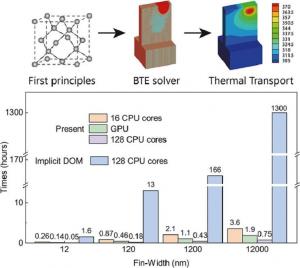Breakthrough in Submicron Transistor Thermal Simulation through Efficient Phonon BTE Method
GA, UNITED STATES, September 25, 2024 /EINPresswire.com/ -- This study presents a highly efficient thermal simulation method using a non-gray phonon Boltzmann transport equation. By integrating first-principles phonon properties and advanced computational techniques, the method avoids empirical parameters and achieves remarkable efficiency, solving large-scale 3D problems in under two hours on a personal computer. It enables predictive design of nanostructures with specific thermal conductivity and accurately resolves temperature profiles at the transistor level, aiding in understanding self-heating effects in electronics.
As electronic devices become increasingly miniaturized, heat management at the nanoscale emerges as a challenge, especially for devices operating in sub-microns. Traditional heat conduction models fail to capture the complex behavior of thermal transfer at this scale, where phonons—vibrational energy carriers in the lattice structure—dominate.
In particular, there are to key obstacles in phonon-based heat simulation to address. One is the reliance on empirical parameters, which limits the model's adaptability across different materials, while the other is the enormous computational resources required for three-dimensional (3D) simulations.
In a study (https://doi.org/10.1016/j.fmre.2022.06.007 ) published by a team of researchers from Shanghai Jiaotong University, led by thermophysics professor Hua Bao, a novel computational method which addresses these challenges was reported.
“When device sizes shrink to scales comparable to the phonon mean free path, the classical Fourier law no longer applies,” explains Bao. “To model heat conduction accurately, we must use the phonon Boltzmann transport equation (BTE). That said, solving this equation efficiently for 3D structures has been a challenge.”
Nonetheless, by applying the Fermi's golden rule to precisely calculate the necessary parameters from first principles, the team successfully eliminated the need for empirical parameters. This breakthrough allows the model to be applied across a wide range of materials while maintaining high accuracy.
Further, the introduction of advanced numerical algorithms dramatically boosts simulation efficiency. For instance, a 3D FinFET device with 13 million degrees of freedom, which previously would have required hundreds of CPU cores over several hours, can now be simulated in under two hours on a regular desktop computer.
“Our method not only reduces computational costs but also enables accurate thermal simulations for complex nanoscale structures, providing critical insights for designing materials with specific thermal properties and accurately resolving temperature profiles at the transistor level,” says Bao.
In addition to the algorithmic improvements, the team developed GiftBTE, an open-source software platform designed to facilitate further advancements in sub-micron heat transfer simulation. The researchers hope their approach will pave the way for future studies and real-world applications in nanoelectronics and thermophysics.
“We believe our work will encourage other scientists to explore new applications for BTE-based simulations, particularly in complex multi-physical scenarios like electro-thermal coupling in devices,” Bao adds.
DOI
10.1016/j.fmre.2022.06.007
Original Source URL
https://doi.org/10.1016/j.fmre.2022.06.007
Funding information
This study acknowledges the support by the National Natural Science Foundation of China (Grant No. 52122606).
Lucy Wang
BioDesign Research
email us here
Legal Disclaimer:
EIN Presswire provides this news content "as is" without warranty of any kind. We do not accept any responsibility or liability for the accuracy, content, images, videos, licenses, completeness, legality, or reliability of the information contained in this article. If you have any complaints or copyright issues related to this article, kindly contact the author above.

